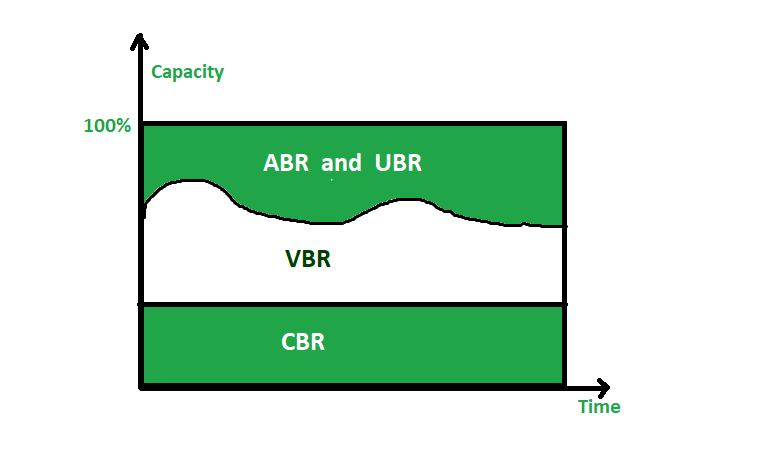Quality of Service (QoS) in ATM
Last Updated :
08 Jul, 2022
Quality of Service (QoS) is a type of Networking Technology that can guarantee a specific level of output for a specific connection, path, or type of traffic. QoS mechanisms provide control on both quality and availability of bandwidth whereas another network provides only a best-effort delivery.
QoS feature is used when there is traffic congestion in-network, it gives priority to certain real-time media. A high level of QoS is used while transmitting real-time multimedia to eliminate latency and dropouts. Asynchronous Transfer Mode (ATM) is a networking technology that uses a certain level of QoS in data transmission.
The Quality of Service in ATM is based on following: Classes, User-related attributes, and Network-related attributes.
These are explained as following below.
1. Classes :
The ATM Forum defines four service classes that are explained below –
- Constant Bit Rate (CBR) –
CBR is mainly for users who want real-time audio or video services. The service provided by a dedicated line. For example, T line is similar to CBR class service.
- Variable Bit Rate (VBR) –
VBR class is divided into two sub classes –
- (i) Real-time (VBR-RT) :
The users who need real-time transmission services like audio and video and they also use compression techniques to create a variable bit rate, they use VBR-RT service class.
- (ii) Non-real Time (VBR-NRT) :
The users who do not need real-time transmission services but they use compression techniques to create a variable bit rate, then they use VBR-NRT service class.
- Available Bit Rate (ABR) –
ABR is used to deliver cells at a specific minimum rate and if more network capacity is available, then minimum rate can be exceeded. ABR is very much suitable for applications that have high traffic.
- Unspecified Bit Rate (UBR) –
UBR class and it is a best-effort delivery service that does not guarantee anything.

The above diagram shows relationship of different classes to total capacity of network.
2. User Related Attributes :
ATM defines two sets of attributes and User-related attribute is one of them. They are those type attributes that define at what speed user wants to transmit data. These are negotiated during time of contract between a network and a customer.
The following are some user-related attributes –
- Sustained Cell Rate (SCR) –
SCR is average cell rate over a long time interval. The original cell rate can be less or greater than value of SCR, but average must be equal to or less than value of SCR.
- Peak Cell Rate (PCR) –
PCR is defined as maximum cell rate of sender. As long as SCR is maintained, cell rate of user can reach this peak value.
- Minimum Cell Rate (MCR) –
MCR defines minimum cell rate acceptable to sender. For example, if MCR is 50,000, network must guarantee that sender can send at least 50,000 cells per second.
- Cell Variation Delay Tolerance (CVDT) –
CVDT is a measure of the variation in cell transmission times. Let’s take an example if value of CVDT is 8 ns, this signifies that difference between minimum and maximum delays in delivering the cells should not be greater than 8 ns.
3. Network-Related Attributes
The attributes that are used to define different characteristics of network are known as Network-related attributes.
The following are some network-related attributes –
- Cell Loss Ratio (CLR) –
CLR defines the fraction of cells lost (or delivered so late that they are considered lost) during transmission. For example, if sender sends 100 cells and one of them is lost, CLR is
CLR = 1/100
- Cell Transfer Delay (CTD) –
The average time taken by a cell for traveling from source to destination is known as Cell transfer delay. The maximum CTD and minimum CTD are also considered attributes.
- Cell Delay Variation (CDV) –
CDV is difference between CTD maximum and CTD minimum.
- Cell Error Ratio (CER) –
CER defines fraction of cells delivered in error.
Share your thoughts in the comments
Please Login to comment...